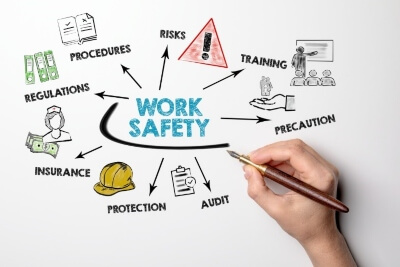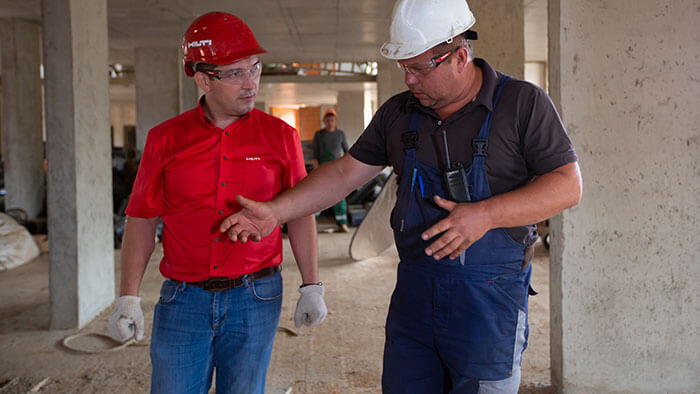The modern workplace is a very dynamic and complex environment.
I am fortunate to visit many clients representing the diversity of the industries that make up our economy. While every sector, division, or employer is unique in their own way – there is a commonality found in all – statutory obligations.
Whether it be the Employment Standards Act (ESA), Human Rights Code, or the Occupational Health and Safety Act (OHSA), all organizations have legal requirements that they must follow.
Any of you who have read these pieces of legislation will know that there are many generalities within the statutes mentioned above. What I find most fascinating is how each organization interprets and implements these requirements.
As an HR professional specializing in Occupational Health and Safety, I tend to focus on the provisions and regulations regarding my field most directly.
The Occupational Health and Safety Act as a standalone document gives organizations the fundamentals of structure to ensure a safe workplace. It is supplemented by the regulations, which give specific detail based on industry.
The latter is a topic for another day, but what I would like to explore here is how this provided structure creates a safe work environment.
In terms of the organizational arrangement, we can have horizontal or vertical configurations or some hybrid form. Either way, there is still a power structure with the employer in control of the environment.
When an employer is committed to safety, perfect.
However, if they are not, due to lack of knowledge, expertise, or pure desire – our structure provides for this as well. What I am talking about is the Joint Health and Safety Committee.
Throughout the next parts of this article, we will walk through topics ranging from certification to investigations.
Joint Health & Safety Committees

So, if you are reading this, you probably meet the requirements for establishing a committee found in S. 9(2) of the OHSA. How large the committee has to be will depend on worker population S. 9(6) with mitigating factors such as duration in examples like a construction project.
Now, a Joint Health and Safety Committee (or JHSC for short) is a collective approach to managing the workplace’s wellbeing.
Worker and management representation ensures that both perspectives are recognized, respected, and considered with equal merit regarding the scope of the committee, namely being hazard identification and subsequent control.
JHSC’s safeguard against one-sided employer-controlled decisions – otherwise known as recommendations within the committee environment. This does not give the workers the power to override management’s residual right to control their business.
What it does create is a documented discussion where both worker and management viewpoints are considered.
What comes out of these discussions are recommendations that the JHSC feel is necessary to maintain a sustainable safety culture. Workplaces evolve, as does legislation and industry best practices.
Having on-site health and safety resources allows a company to effectively identify potential and actual hazards and institute control measures that will protect the workers, supervisors, and ultimately the employer.
The JHSC itself has listed powers under the act found in S. 9(18), which include the ability to look for hazardous conditions and situations, make recommendations to the employer for corrective actions, establishment and maintenance of programs to protect worker safety, be present at the commencement of testing (such as atmospheric and noise as an example), and access to safety knowledge the employer is aware of.
The act sets minimum standards of meeting and inspection schedules and states the requirement of certified members.
The Certification Process
So, the act states,
“a constructor or employer shall ensure that at least one member of the committee representing the constructor or employer and at least one member representing workers are certified members” S. 9(12)
This begs the question to those newer to health and safety competency – what is a certified member? In reality, it means you have trained members.
The topics included will be discussed later; however, the Chief Prevention Officer (CPO) standard is available on the Ministry’s website if interested.
There are 2 parts to the training required to be a certified member.
A 3-day course covering a variety of topics and information (JHSC Part One), and a follow-up 2-day course that provides industry-specific information (JHSC Part Two).
Being a certified member allows you to carry out your role as a committee member more effectively through knowledge of the act, regulations, applicable standards, etc.
There is also a more significant element of responsibility found with the ability to perform a bi-lateral work stoppage.
I have been to clients where they only have the minimum number of certified members, to the other end of the spectrum – all workers standing for election to the committee are certified at the employer’s expense.
In my experience, an unintended benefit to the certification process is worker confidence.
They have a better understanding of not only the law in regards to safety but also hazard control. They tend to be more active in aiding the employer to find solutions for any safety issue that may arise in their organization.
Duties & Responsibilities and the Internal Responsibility System

Workplaces tend to evolve in one of two ways – positively or negatively.
An environment that places a strong emphasis on health and safety will experience less attrition, lost time, and potentially costly repairs or even fines.
A company with a less than stellar focus on safety may experience losses on those various levels if the workforce’s safety and health is not an area of focus. So, it is evident that positive workplace culture is ideal.
The JHSC, as discussed, can be a great asset supporting what is known as “The Internal Responsibility System“.
The Occupational Health and Safety Act was designed following the principle that Health and Safety in the workplace should be a co-operative venture of the three main parties: employers, supervisors and workers.
In this relationship, employers have the ultimate responsibility for ensuring compliance and protection of the workers.
Supervisors are the employer’s representative at the worker level. They are responsible not only for ensuring compliance but also as a source of information to protect workers from hazards.
The workers are responsible for following all policies, procedures, applicable legislation and ensuring their fellow workers are also in compliance.
This principle of all parties being accountable for workplace Health and Safety is at the heart of the Internal Responsibility System. The employer (S. 25–26), supervisor (S.27), and workers (S.28) have certain rights and responsibilities outlined in the Occupational Health and Safety Act and its regulations.
The Internal Responsibility System (IRS) expects every person in an organization to be directly responsible for health and safety in their job. Everyone must take the initiative to report issues, share information, all with the end goal that issues will be corrected and, as a result, make improvements to health and safety issues on an ongoing basis.
When done effectively, a functional Internal Responsibility System will reduce the number of work-related accidents and illnesses due to continuously controlling hazards.
Another way to think about the IRS is the internal checks and balances measure; it creates accountability through in-house means, rather than relying on government enforcement.
Just as a person driving a car should not require a police officer continuously following them to obey the rules of the road, the workplace parties should not require the Ministry to oversee a company’s safety systems to ensure compliance.
Joint Health and Safety Committee and Legislation
The JHSC acts as a fundamental partner to all parties in the IRS; it intends to hold them accountable for their actions (or inactions) regarding hazardous situations in the workplace.
As we have already discussed, it is the committee’s function, and they have the power to spot hazards and make corrective recommendations. If we consider the purpose of a Ministry inspection, it is to look for areas of non-compliance.
The JHSC can act proactively and incorporate this practice as part of its efforts to maintain a positive safety culture. However, it proves challenging to look for contraventions of the act when you are not sure what it says.
After a bit of instruction and practice with the Occupational Health and Safety Act, it loses its intimidation factor.
To set out the intent of written legislation, the OHSA and its regulations dedicate Section 1 to spell out applicable definitions. This clarifies what terms mean within the legislation’s context and is easily accessible to those JHSC members who are not regularly exposed to it.
Another challenge JHSC members face is how to locate specific provisions applicable to their organization. The OHSA and associated regulations have an index.
The index can be found at the very back of the Green Book found in your workplace. It can be useful in identifying where specific information can be found within the legislation.
The alphabetical listing will identify the section and the page number where the information is located.
Note that the index is not a legal part of the legislation and is merely an aid for finding specific information.
As with other search tools, if a word or phrase cannot be found, consider different wording. An example being “notification of accident” can be found in the index for Ontario Reg 851 and Ontario Reg 67, but “accident notification” is wording found for Ontario Reg 213.
Understanding the Occupational Health & Safety Act structure clarifies how an organization supports the Internal Responsibility System.
The OHSA outlines the duties and responsibilities of Employers, Supervisors, Workers, Ministry Inspectors, and the Joint Health and Safety Committee.
The OHSA supports a worker’s right to know about hazards in the workplace, the right to participate in their health and safety (best achieved by being a member of the JHSC), and the right to refuse unsafe work.
It dictates the workplace management of toxic substances, hazardous materials, and hazardous physical agents. In dealing with these elements, the JHSC members ensure acceptable solutions to all involved parties are recommended and, most importantly, implemented.
As a quick overview of how to read the legislation, specific topics are broken down into sections.
The heading can identify the topic of the individual section. Headings describe the contents of a part, section, or sub-section more precisely.
They are usually displayed in bold and give a brief description of what information can be found in that specific location.
Sections provide information relating to the particular and specific subject grouped together and are denoted by a number, in bold, with a period beside it. Example – (S. 9)
Next, there is a subsection. Subsections expand on the central theme of a section and are denoted by a number enclosed in parentheses or round brackets. Example – (S. 9 (18))
Following the subsection are the clauses. Clauses delve into a deeper level of information. They are identified by a lower-case letter in parentheses or round brackets. Example – (S. 9 (18)(d))
Lastly are the sub-clauses. Sub-clauses expand on the information provided in a clause. They are identified by a Roman numeral in parentheses or round brackets. Example – (S. 9 (18)(d)(i))
Depending on the subject matter, a section may be able to express the entire thought effectively. In other cases, greater levels of depth may dictate that sub-sections, clauses, or even sub-clauses be used.
JHSC members will review relevant information contained in applicable sections to aid in ensuring compliance in the workplace. The citation style given above can be found on many JHSC created documents such as inspection reports, 21-day letters, and accident investigations.
JHSC and Hazards – The RACE Methodology (Recognize, Assess, Control, Evaluate)
So, after all of that, we finally arrive at hazards.
The function and purpose of the committee always surround the identification and control of hazards.
One of the most significant elements covered in the JHSC certification course is what the Ministry refers to as the RACE Methodology. It is a structured tool to ensure that employers and committees have a consistent and thorough process to distinguish sources of danger, evaluate their potential risk, ascertain an appropriate control, and apply a procedure of continuing evaluation.
RACE stands for recognize, assess, control, and evaluate.
Starting off with RACE, Recognition of hazards is the first step.
You cannot fix a problem that you do not know exists. Look at smoking rates over the years. Before it was widely accepted (or recognized – see what I did there?) that there are associated health risks, tobacco consumption levels were high.
Today, where the known consequences are established, the levels are lower. In your workplace, the same logic applies.
The JHSC will use 6 tools to identify these situations of danger to your workers.
- Inspections – the proactive approach
Consciously examining the physical location of your workplace for potential sources of danger. Looking for issues before the problem arises. - Investigations – the reactive approach
This occurs when something has gone wrong. An injury, property damage, work refusal, near miss, etc. Isolate the root cause of the contributing factors to uncover the previously unknown hazard. - Job-Hazard Analysis (JHA) – step by step approach
Think standard operating procure (SOP) used to ensure consistency of workflow, but change the focus. Determine the hazards associated with a given task at each step, the risk, and controls put in place by your organization. - Observations – being situationally aware
At work, you are always consciously walking around looking for hazards. You should most likely be paying attention to what you are doing!The good old “eyes on task, mind on task” mentality. However, with a keen sense of self-preservation, you should be aware of your environment. Using your observation powers (sight, sound, touch, taste, and smell) can alert you that something is out of the ordinary. How else would you know people stand on chairs when there is a rule about it! I doubt you would catch that activity on an inspection. - Interviews – getting another perspective
Asking those familiar with a task to identify areas of concern will be very useful when trying to manage exposure. What another finds to be an issue might be something that you would personally overlook. This method utilizes everyone’s past experiences to help detect hazards. - Standards and legislation – the formal and informal rules
An employer or JHSC can use the OHSA as the baseline of what is acceptable. If the act or a corresponding regulation specifically prohibits a condition or situation, it is probably due to a previous incident or illness. There are some rather bizarre rules in that green book, O. Reg 213 S. 28 (4) and better yet O. Reg 213 S. 29.1 (1) 2 make you question why they had to be legislated!
The rules are not limited to only the OHSA and regulations. Standards can be either enforceable by law or as industry best practices.
The Ministry of Labour also publishes a set of guidelines on topics such as lifting devices and heat. Probably a good idea to follow them.
After a hazard has been identified during the first step of the RACE methodology, it must be assessed.
Depending on your organization’s choice of risk assessment template, it should encompass elements of exposure frequency and severity of damage to determine the probability of occurrence.
The JHSC, who can establish a reasonable assessment of the overall level of concern regarding a specific hazard, will help make recommendations and control appropriate in the circumstances.
It is essential to be realistic when judging the criteria. Being too harsh will cause people not to take the process seriously, and being too lenient can minimize the worker’s risk.
The second phase of the assessment stage in the RACE methodology is compliance.
Are we legal? Or are we not? The importance of making this distinction is to provide the necessary motivation for employers to take the JHSC as seriously as it is. Identifying a hazard is one thing, but pointing out where it violates a statutory obligation is another.
An employer cannot, in good faith, claim they are committed to a sustainable safety culture if they choose to ignore a violation. They can choose to identify their control, but they must do something about it.
After the RACE methodology’s assessment stage, you know what the hazard is, what the likelihood of damage is, and what contraventions are present. Now a JHSC will work to make a recommendation to control it.
When considering the most suitable control for your organization’s identified hazard, consider what has allowed this hazard to exist. The training standard for the JHSC certification process stipulates the five factors must be considered.
They are people, equipment, materials, environment, and process. After careful consideration of how these factors contribute will help select the most effective control in your situation.
Ideally, there should be some control measures currently in place, and it is always possible to improve on them. However, you could also be faced with an uncontrolled hazard. Either way, this is now when you apply the so proposed controls can be added, as appropriate.
Controls are the various ways in which a hazard can be managed so that its ability to create a hazard is reduced. The five-part system used in order of effectiveness is called the hierarchy of controls:
- Elimination, the first control at the source of the hazard. Just stop doing it! Storing an unused chemical? Get rid of it! Do not think your workers should do the task? Subcontract it out to a company that specializes in that type of thing.
- Substitution, the second control at the source of the hazard. Change something out, use a safer chemical (acetone vs ethyl acetate), or apply a different process (spraying vs dipping).
- Engineering, the third control at the source of the hazard. Utilizing a designed system to prevent a worker from being injured. Interfaced controls that work automatically, light curtains, guardrails, floor grates, etc.
- Administrative, the only control along the path towards the worker. Here we find policies, procedures, warning signs, and laws. These controls may not be as adequate as they are only as good as they are enforced.
- Personal Protective Equipment, the only control at the worker. The common sights around many workplaces, eye, ear, respiratory, or other similar protection. This should always be the last line of defense as we are not controlling the hazard, just the worker’s exposure to it. This is, however, more often than not taken as the easy way out.
The last stage of the RACE methodology is evaluation. Remember, history tends to repeat itself.
The JHSC, and other workplace parties, need to critically look at the control systems that have been put in place to determine what is working and what is not.
The goal of hazard control is not to do something that looks good or might work but to deal with a specific concern.
You should always ask 3 questions at this stage.
Firstly, did the control actually work? Has the risk to the worker been reduced to an acceptable level?
Secondly, did the control we put in place cause any new hazards? What initially seems like a good idea can have unintended consequences.
Lastly, can my control be improved upon? After allowing the original control to function for a period, check to see if improvements are possible; you can never be too safe! Be wary of cheap controls.
Quick and straightforward responses are rarely the best long-term solutions. Frequently, control measures that would seem to be excessive or too costly have other benefits to productivity and or quality, which results in them being the better choice in the long term.
Workplace Inspections

Above, it was previously mentioned that workplace inspections are an excellent proactive tool; they are also a legal requirement under the OHSA. Employers and the JHSC can have separate inspections; the differences are reporting requirements and frequency.
Employers should have their supervisors often inspect, if not daily. This supports the IRS in terms of always being aware of hazards, which requires them to advise workers at risk.
The JHSC inspection, on the other hand, is done monthly. A worker member of the JHSC is responsible for this. They examine the physical location at least once a month, looking for violations of law, and more importantly, violations of the organization’s health and safety program.
As mentioned in a previous post, the law is the statutory minimum – you cannot go below it. Going above? It is pretty much an expectation at this point.
The health and safety program categorizes the workplace hazards and lists the controls in place, whatever they may be. If those controls are failing, which are the employer’s set expectation – there is a hazard present specific to your organization’s own rules.
The most effective inspections are conducted by those trained in what to look for.
Generally, it is recommended (although they do not have to be) that a certified JHSC member perform the inspection.
Accident / Incident Investigation
Similar to inspections, there are employer investigations and JHSC investigations.
Depending on the severity of the damage or injury, there might also be a Ministry investigation as well. Management investigates with their authority and liability from their perspective, the JHSC from the worker’s point of view – they do not always align.
Whatever side of the management divide you fall on does not really matter as both are trying to isolate the root cause of that incident.
After careful consideration of the evidence and sorting the contributing factors mentioned above (people, equipment, materials, environment, and process), the root cause – the one thing that sets off the chain of events is exposed.
The root cause should be based on as much evidence as possible to eliminate the preconceived biases we might carry with us.
Simply put, the root cause is a hazard. One that has previously caused damage, which is why it is considered imperative that it is corrected.
Not unlike any other hazard in the workplace, once recognized, it must be assessed, controlled, and steps for evaluation put in place (you guessed it, the RACE methodology again!).
Additional Resources & Information
The last topic we will cover here will be about how much information is out there.
Starting at the beginning is that handy dandy green book you have hanging off the health and safety board.
It is hard to follow laws you do not know exist. All members of the IRS should understand their respective roles as per legislation.
Next are the regulations; what O. Regs do you have to follow in your organization? O. Regs 851, 213, 67, 297, 833 are common, but there are many more.
Do you even know when what applies?
Construction (O. Reg 213) can apply if you meet the definition of “construction” for in the OHSA, not only if you are filing your S.6 notice of project!
After that, we have Ministry guidelines, CSA standards, and, most importantly, your own company’s policies in the mix. Knowing what is out there and what applies to your organization is an excellent preventative measure against an unwelcome surprise.
However, remember what is out there today could change tomorrow.
A JHSC, to be effective, has to stay in touch with current events. Look at the amendments for O. Reg 833.
Remember, knowledge is power, and with so much information available, it is hard to claim you had no way of knowing. Sorting it all out?
Well, that’s why Industrial Safety Trainers exist.
Geoff Rowatt, CHRP|CHRL
Industrials Safety Trainers Inc.





